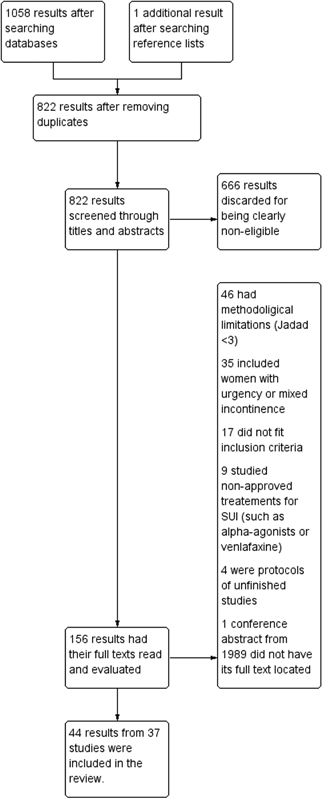-
Systematic Review11-01-2017
Management of Axillary Web Syndrome after Breast Cancer: Evidence-Based Practice
Revista Brasileira de Ginecologia e Obstetrícia. 2017;39(11):632-639
Abstract
Systematic ReviewManagement of Axillary Web Syndrome after Breast Cancer: Evidence-Based Practice
Revista Brasileira de Ginecologia e Obstetrícia. 2017;39(11):632-639
Views206Abstract
Axillary web syndrome is characterized as a physical-functional complication that impacts the quality of life of women who have undergone treatment for breast cancer. The present study aims to verify the physiotherapy treatment available for axillary web syndrome after surgery for breast cancer in the context of evidence-based practice. The selection criteria included papers discussing treatment protocols used for axillary web syndrome after treatment for breast cancer. The search was performed in the MEDLINE, Scopus, PEDro and LILACS databases using the terms axillary web syndrome, lymphadenectomy and breast cancer, focusing on women with a previous diagnosis of breast cancer who underwent surgery with lymphadenectomy as part of their treatment. From the 262 studies found, 4 articles that used physiotherapy treatment were selected. The physiotherapy treatment was based on lymphatic drainage, tissue mobilization, stretching and strengthening. The four selected articles had the same outcome: improvement in arm pain and shoulder function and/or dissipation of the axillary cord. Although axillary web syndrome seems to be as frequent and detrimental as other morbidities after cancer treatment, there are few studies on this subject. The publications are even scarcer when considering studies with an interventional approach. Randomized controlled trials are necessary to support the rehabilitation resources for axillary web syndrome.
Key-words axillary web syndromeconservative treatmentcordingLymphadenectomyPhysiotherapyRehabilitationSee more -
Original Article04-01-2016
Association between the Functionality of Pelvic Floor Muscles and Sexual Satisfaction in Young Women
Revista Brasileira de Ginecologia e Obstetrícia. 2016;38(4):164-169
Abstract
Original ArticleAssociation between the Functionality of Pelvic Floor Muscles and Sexual Satisfaction in Young Women
Revista Brasileira de Ginecologia e Obstetrícia. 2016;38(4):164-169
Views95See moreAbstract
Objective
The objective of this study is to associate the results obtained while assessing the pelvic floor muscles (PFM) functionality with the score of sexual satisfaction of young adult women.
Methods
This is an observational and cross-sectional study. The inclusion criteria were women aged between 20 and 40 years who have had sexual intercourse, nulliparous, BMI lower than 25 kg/m2, and absence of pelvic floor dysfunction. The evaluation consisted of both the medical history and assessment of the PFM functionality using the Perina pressure biofeedback and Oxford Scale. We measured sexual satisfaction using the Female Sexual Quotient questionnaire and used the KolmogorovSmirnov test to verify the normality of the data. We analyzed non-parametric variables using the Spearman correlation test. The significance level was 5 %.
Results
A total of 80 women with a median age of 26 years and median BMI of 21.64 kg/m2 participated in this study. We divided the subjects into two groups, best and worse PFM functionality, according to median Perina pressure biofeedback and Oxford scale. We found no difference between the groups when comparing the sexual satisfaction scores. There was only a slight significant correlation between the Contraction Voluntary Average obtained using the pressure biofeedback and the primary domain (r = 0.27; p = 0.01).
Conclusion
This study found a slight correlation between PFM functionality and the functionality of the primary domain of the Female Sexual Quotient questionnaire. Therefore, it is not possible to state whether there is an association between the PFM functionality and female sexual satisfaction in young adults.
-
Original Article08-07-1999
Physiotherapy for reduction of diastasis of the recti abdominis muscles in the postpartum period
Revista Brasileira de Ginecologia e Obstetrícia. 1999;21(5):267-272
Abstract
Original ArticlePhysiotherapy for reduction of diastasis of the recti abdominis muscles in the postpartum period
Revista Brasileira de Ginecologia e Obstetrícia. 1999;21(5):267-272
DOI 10.1590/S0100-72031999000500004
Views112See morePurpose: to check if physiotherapy immediately after childbirth may contribute to early diastasis reduction. Methods: longitudinal and randomized study with 50 parturient women recruited in the Maternidade-Escola Hilda Brandão of the Santa Casa of Belo Horizonte, from April to September 1998. The control group (N = 25) was submitted to evaluation and measurement (6 h and 18 h after labor), and the treatment group (N = 25) was submitted to the same evaluation and measurement as above, as well as to a protocol for physiotherapeutic assistance, 6 and 18 h after labor. For the evaluations, a pachymeter, a precision instrument, was used to measure diastasis. Results: at 18 h after parturition, the control group presented a diastasis reduction of 5.4%, and the treatment group of 12.5%, as related to the first measure (6 h after delivery) (p<0.001, with a confidence interval of 99%). Conclusions: these results show that the physiotherapeutic assistance immediately after childbirth determines a significant reduction in the diastasis of the recti abdominis muscles (DRAM) after every treatment session, as well as a relevant reduction when compared to the control group, positively contributing to the earlier recovery of the recti abdominis muscles.



